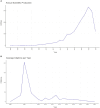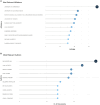Global trends and collaborative networks in gut microbiota-insulin resistance research: a comprehensive bibliometric analysis (2000-2024)
- PMID: 39211341
- PMCID: PMC11358073
- DOI: 10.3389/fmed.2024.1452227
Global trends and collaborative networks in gut microbiota-insulin resistance research: a comprehensive bibliometric analysis (2000-2024)
Abstract
Background: The human gut microbiota plays a crucial role in maintaining metabolic health, with substantial evidence linking its composition to insulin resistance. This study aims to analyze the global scholarly contributions on the relationship between intestinal microbiota and insulin resistance from 2000 to 2024.
Methods: A bibliometric analysis was conducted using data from Scopus and Web of Science Core Collection. The search strategy included terms related to "Gastrointestinal Microbiome" and "Insulin Resistance" in the title or abstract.
Results: The analysis of 1,884 relevant studies from 510 sources was conducted, revealing a mean citation of 51.36 per manuscript and a remarkable annual growth rate of 22.08%. The findings highlight the significant role of gut microbiota in insulin resistance, corroborating prior studies that emphasize its influence on metabolic disorders. The literature review of the current study showed key mechanisms include the regulation of short-chain fatty acids (SCFAs) and gut hormones, which are critical for glucose metabolism and inflammation regulation. The analysis also identifies "Food and Function" as the most productive journal and Nieuwdorp M. as a leading author, underscoring the collaborative nature of this research area.
Conclusion: The consistent increase in publications in the field of gut microbiota and insulin resistance indicates growing recognition of the gut microbiota's therapeutic potential in treating insulin resistance and related metabolic disorders. Future research should focus on standardizing methodologies and conducting large-scale clinical trials to fully realize these therapeutic possibilities.
Keywords: gastrointestinal microbiome; gut microbiota; insulin resistance; insulin sensitivity; short-chain fatly acids.
Copyright © 2024 Abildinova, Benberin, Vochshenkova, Afshar, Mussin, Kaliyev, Zhussupova and Tamadon.
Conflict of interest statement
AA and AT were employed by PerciaVista R&D Co. The remaining authors declare that the research was conducted in the absence of any commercial or financial relationships that could be construed as a potential conflict of interest.
Figures








References
Publication types
LinkOut - more resources
Full Text Sources

